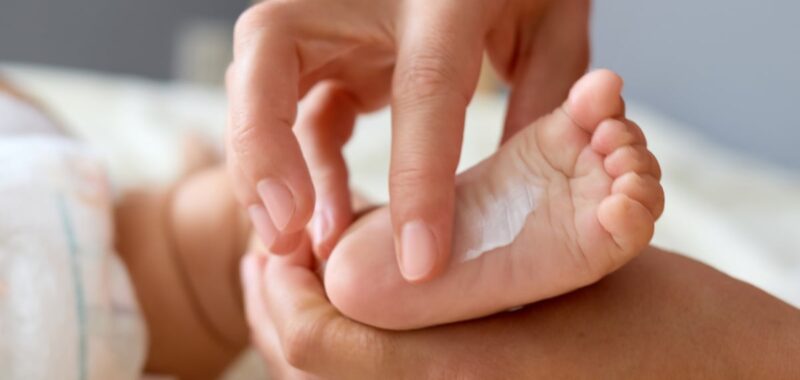
A recent biomonitoring study published in the Journal of Exposure Science and Environmental Epidemiology has found that lotion use is a strong predictor of paraben exposure in young infants, raising new concerns about personal care product safety for this vulnerable population.
The study, characterized by its authors as the “first paper to report paraben levels and evaluate predictors of exposure in infants,” analyzed urinary biomarkers in infants at one to three months and again at 12 months to assess paraben levels and identify potential sources of exposure.
The study and its findings
The study authors reported that lotion use in the last seven days was the strongest predictor of urinary paraben biomarkers of exposure in one to three-month-olds. They noted that “lotion users had 189% higher concentrations of PP and 355% higher concentrations of MP compared to infants who did not have lotion applied in the last seven days.”
These compounds – propylparaben (PP) and methylparaben (MP) – are widely used preservatives in personal care products.
The study found less pronounced associations at the 12-month mark, which researchers attributed to changing exposure pathways as children grow. “The lack of statistical significance at the 12-month-old visit… may reflect changing patterns of exposure as infants age, such as a paraben exposure from a more varied diet and exposure to dust and other products,” the authors stated.
Other predictors of higher paraben levels included race/ethnicity and parental education. While not statistically significant at the 12-month checkpoint, the researchers hypothesized that these demographic indicators may reflect unmeasured differences in product use or household exposure.
Additionally, infants attending daycare at 12 months showed higher paraben concentrations. The authors suggest this may stem from hygiene routines in childcare settings, citing earlier studies showing higher paraben levels in adults who frequently used hand soap.
Notably, the study did not find breastfeeding to be a contributing factor. “We did not observe an association between breastfeeding and infant paraben levels,” the authors wrote, adding that other sources – such as parental use of personal care products – may be contributing to passive exposure.
Though levels observed in infants were lower than in older age groups, the findings underscore concerns about exposure during a critical developmental window. “Infants may be more susceptible to environmental chemicals and their rapid development and underdeveloped defense mechanisms can potentially make these exposures more harmful than later life exposure,” the researchers concluded
Industry expert reacts: Reformulation, transparency, and new preservation strategies
In response to the study’s findings, Dr. Barbara Olioso, founder of the sustainable product finder technology Green Chem Finder, emphasized the implications for cosmetic product development. “I welcome this study as it can potentially impact the way ingredient safety is evaluated, especially in infants’ skin,” she said.
“Even though an infant’s skin looks perfect and beautiful, the stratum corneum is thinner, and the ratio of body surface and body weight is higher than adults, making them more prone to absorption of topical substances.”
Dr. Olioso also pointed to another possible exposure route not fully captured by the study: “This study hypothesizes another source of contamination – the skin-to-skin contact with parents using all sorts of toiletries and passing them on to their babies.”
She called the findings “a call for formulators and manufacturers to replace them in infant and even children’s products to avoid loss of market share or even potential lawsuits.”
When asked about balancing safety and preservation, Dr. Olioso noted the importance of using preservative systems more strategically. “The solution… is to use boosters and multifunctional ingredients as part of the preservative system along with traditional preservatives, [which] allows lower levels of exposure as well as diversification with different substances.”
Dr. Olioso highlighted her own efforts to address these challenges through Green Chem Finder, an ingredient sourcing platform built on green chemistry principles. “The platform features over 300 ingredients from 40 suppliers, all selected using green chemistry criteria… simplifying the process of identifying optimal candidates for effective, compliant, and sustainable preservation systems.”
For baby and sensitive skin products, she recommended “waterless products for leave-on applications, and for rinse-off products the classic organic acids combined with boosters for lower exposure.”
From a market perspective, she said consumer sentiment is already influencing formulation decisions. “Once [consumers] lose trust in specific ingredients, reversing that perception becomes extremely challenging for brands.”
Further, she continued, “this study may vindicate consumer skepticism about parabens, potentially strengthening the market shift toward paraben-free formulations for good.”
She also noted that regulatory evolution must catch up with emerging data. “Regulatory bodies should prioritize funding for such studies and create frameworks that incorporate their findings into safety standards, especially for products intended for vulnerable populations like infants.”
Source: Journal of Exposure Science and Environmental Epidemiology
(2025). https://doi.org/10.1038/s41370-025-00756-4
“Young infants’ exposure to parabens: lotion use as a potential source of exposure.”
Authors: Boxer, E., Zhong, Y., Levasseur, J. et al.

